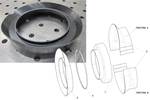Airbus Helicopters introduces light twin H140 with 2028 EIC
Larger, quieter rotorcraft offering is backed by H135 and Bluecopter program know-how, featuring several optimized elements and just as many composite features.
Source | Airbus Helicopters
Airbus Helicopters (Marignane, France) has unveiled a new platform, the H140, a 3-tonne class rotorcraft that is meant to complement the company’s current light twin offerings — the H135 and H145 — for emergency medical services, passenger transport, and private and business aviation markets. Airbus Helicopters has planned a 2028 entry into service, particularly for the emergency medical services segment.
The H140’s development is backed by the company’s R&T programs, such as Bluecopter. “We worked hand in hand with our H135 customers to bring their additional requirements together in the H140’s efficient design.” notes Bruno Even, CEO of Airbus Helicopters. “It enables customers to benefit from a bigger, mission-enhancing cabin space that was sized to an optimized engine performance for best-in-class payload and range.”
In addition to a five-blade main rotor and T-shaped tail boom, the H140 also gains a new powerplant, the 700shp (520-kiloWatt)-rated Safran Helicopter Engines Arrius 2E, an improved Fenestron shrouded tail rotor and a clutch of other enhancements.
The H140 is meant to be a derivative of the H135, which replaced an aluminum primary structure with carbon fiber-reinforced polymer (CFRP) using a multi-piece preform and single-shot infusion. The H135’s tailboom and tail rotor shroud are also CFRP, and the propeller blades are composite (read “Composite ring frame improves safety, cost for workhorse helicopter”). that the H140 maintains a composite tail boom, adding that the Fenestron surround is also composite.
While similar, perhaps, to the H135 in some ways, the H140 is different in others. Moreover, not everything tested on the Bluecopter program platform has made its way to this light twin craft. “The idea for this program is to raise the bar in terms of performance, technology and value in the light-twin segment,” Even tells FlightGlobal. “We expect a lot from the introduction of this new program,” and that it will benefit “from the maturity and the reliability of our existing product range.”
To date, the H140 program has already “accumulated around 55 flight hours and envelope expansion work is almost complete.” In total, the company will have four dedicated prototypes. Final assembly of the helicopter will take place on Airbus Helicopters’ mixed H134/145 line at its site in Donauwörth, Germany.
Related Content
-
Prepreg compression molding supports higher-rate propeller manufacturing
To meet increasing UAV market demands, Mejzlik Propellers has added a higher-rate compression molding line to its custom CFRP propeller capabilities.
-
Welding is not bonding
Discussion of the issues in our understanding of thermoplastic composite welded structures and certification of the latest materials and welding technologies for future airframes.
-
Bladder-assisted compression molding derivative produces complex, autoclave-quality automotive parts
HP Composites’ AirPower technology enables high-rate CFRP roof production with 50% energy savings for the Maserati MC20.






